Helping Black Boys Heal From Violence, Trauma
The story was co-published with The Sacramento Observer as part of the 2024 Ethnic Media Collaborative, Healing California.

Termir Knox, 16, leads a Hooked On Fishing, Not Violence session on an evening when boys were asked to write about traumatic experiences. Knox, who balances participation with various sports commitments, says Black male students are often discriminated against and unfairly punished in local school settings.
Russell Stiger Jr., OBSERVER
Family, friends, coaches and teammates wore black and orange in tribute to a little boy gone too soon. One by one, they made their way to the front of Liberty Towers Church to say goodbye. Among them, a toddler who had to be lifted up by his mother as he was too small to see inside the casket.
Keith “KJ” Frierson’s loved ones spoke of his kind and generous nature and vowed to never forget him or his ever-present smile. The 10-year-old was fatally shot by another 10-year-old boy on December 30. The killing reportedly happened after the shooter lost a bike race, retrieved his father’s gun from his vehicle and returned to fire it at Frierson. As a minor, the shooter was arrested and released. Instead, his father, Arkete Davis, now faces a number of charges, including child endangerment, accessory after the fact and being a felon in possession of a gun, which turned out to be stolen.
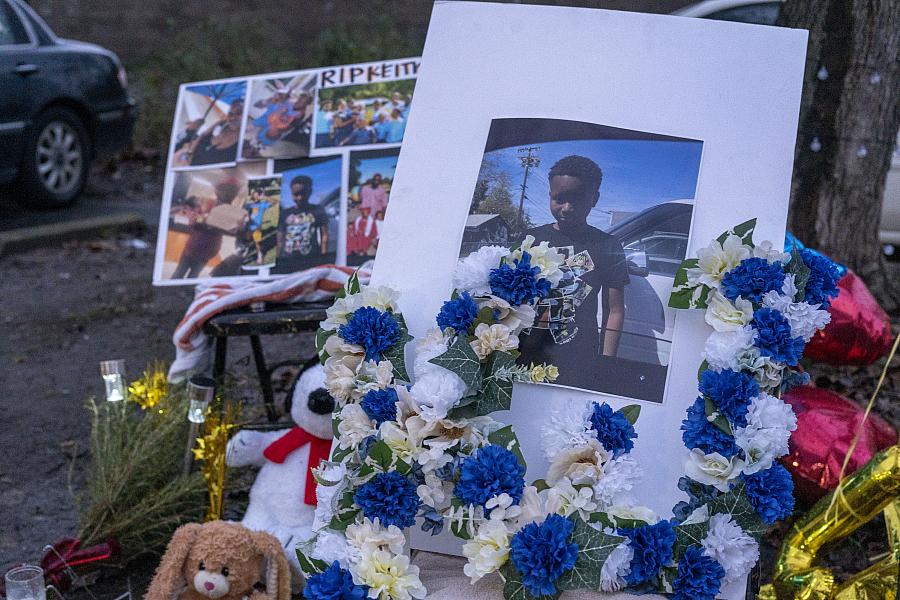
A memorial for 10-year-old Keith “KJ” Frierson was erected after the local boy was fatally shot by another child of the same age last December. Such tragedies leave families and communities with scars.
Russell Stiger, Jr
"We cannot let this boy’s murder be a one-day news story and forgotten about by tomorrow morning,” Sheriff Jim Cooper said via X, formerly known as Twitter.
Cooper was referring to the issue of people illegally possessing guns and using them to commit violent crimes, but his remarks are echoed by local mental health advocates. In the wake of such senseless tragedies, the Black community is seeking ways to help young Black boys heal from violence and trauma and process stress, anxiety, racism, and other weights they carry on their shoulders. Community-based organizations are increasingly being called upon to step in and help mitigate future harm by offering interventions and other resources.

Genoa Barrow, Sacramento Observer
Another small child is said to have witnessed Frierson being killed.
“All this happened in front of another 6-year-old child who saw the whole thing,” Sheriff Cooper said. “The trauma that child experienced always gets overlooked.”
And what of the child who has to live with taking someone’s life? What scars will he have?
Paying attention
Research from the National Child Traumatic Stress Network suggests that approximately 25% of children in the U.S. experience at least one traumatic event by the age of 16. The National Council of Mental Wellbeing places the number of American adults who have experienced a traumatic event during the course of their lives at 70%.
Experts and advocates point to ACEs, or adverse childhood experiences, that can contribute to mental health challenges and a greater likelihood of developing chronic diseases in adulthood.
Liberty Towers Church, where Frierson’s service was held, is a leader for the Foothill Farms/North Highlands area in the Black Child Legacy Campaign (BCLC) that seeks to reduce deaths of African American children in Sacramento County.
Foothill Farms/North Highlands is one of the BCLC’s seven focus areas due its crime rates. According to the BCLC, residents of communities with high crime rates experience high levels of stress and “victims of violent and other crimes experience trauma that compromises psychological as well as physical well being.”
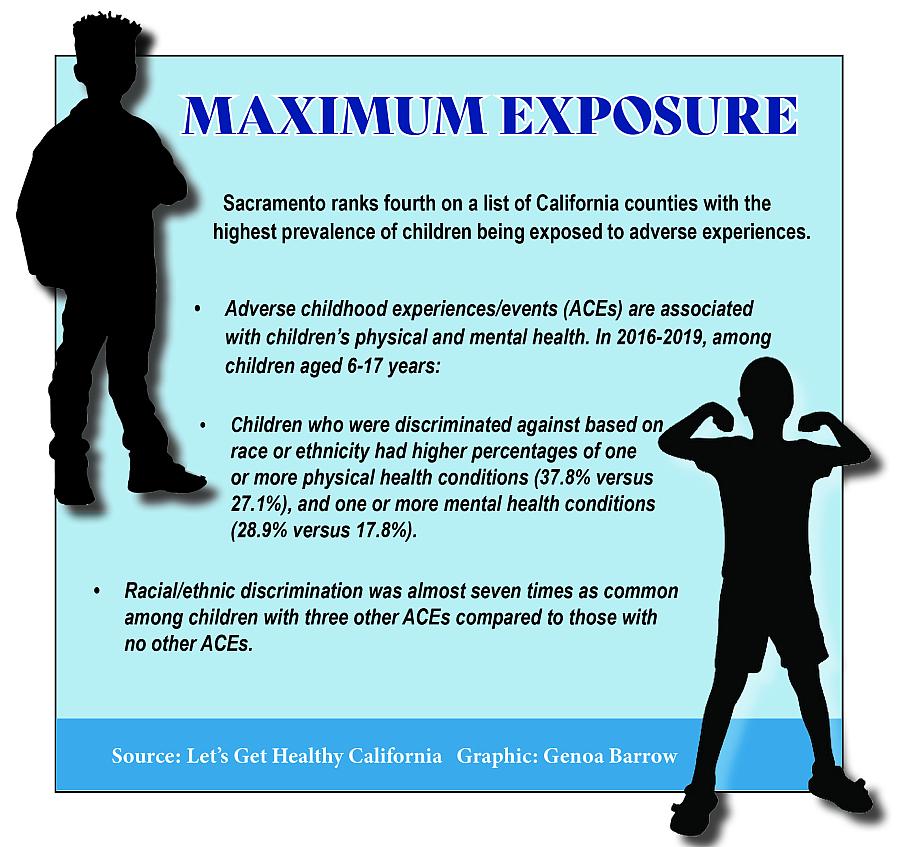
Genoa Barrow, Sacramento Observer
In the late 1990s, Kaiser and the Centers for Disease Control and Prevention (CDC) identified the 10 ACEs of trauma: physical abuse, sexual abuse, emotional abuse, physical neglect, emotional neglect, mental illness, divorce, exposure to domestic violence, substance abuse, and having an incarcerated relative. Five additional adverse childhood experiences — experiencing racism; growing up in foster care, or having an experience of foster care; being bullied; or witnessing community violence — were added by a Philadelphia ACEs study to reflect that experiences of many people of color were left out of the equation. The original ACE study only touched on violence between parental figures, or domestic violence, leaving out the trauma of frequent community violence.
“If you have the wrong people asking the wrong questions, if they don’t have the experience to know what constitutes the full range of trauma, then you’re going to miss out on important adverse childhood experiences,” said Dr. Ruth Shim, UC Davis’ associate dean of Diverse and Inclusive Education and director of Cultural Psychiatry.
Response Time
KJ Frierson attended Hazel Strauch Elementary School, within the Twin Rivers School District. Following his death, the district’s Crisis Response Team was on site for three days, counseling 48 individual students. Nearly a dozen needed follow-up appointments. The Crisis Response Team also brought calming circles to several classrooms.
The team has been called upon a lot of late. In January, a boy was injured in an on-campus shooting at Grant High School. A 14-year-old Grant student was arrested. Last May, a Grant student athlete, Billy Scott, was shot and killed just hours before he was set to graduate. Police arrested a local 17-year-old in connection with the murder. In 2015, another Pacer athlete, Jaulon “JJ” Clavo was shot and killed.
Strauch Elementary has a school counselor and a psychologist on site every day. The district employs 72 counselors. So students can see counselors who “look like them,” there has been an effort to have African American men on the counseling staff.
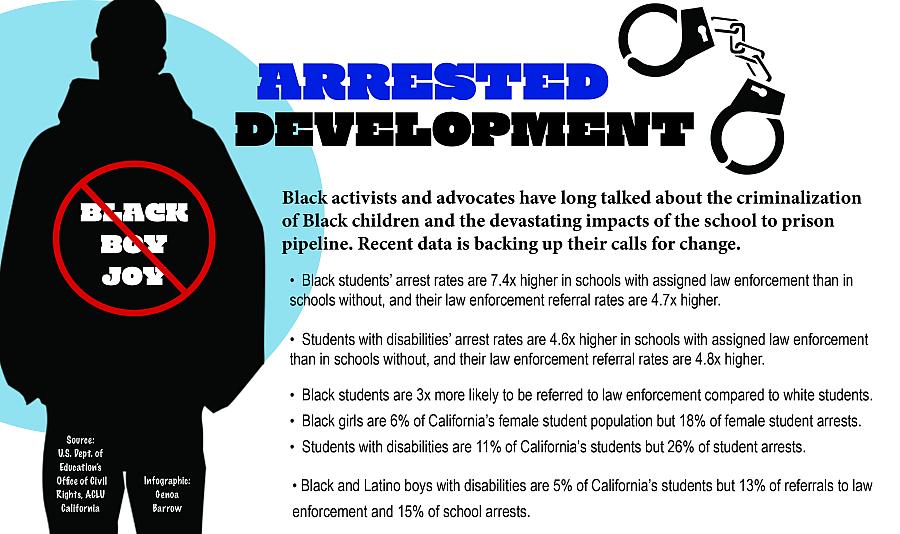
Genoa Barrow, Sacramento Observer
The district has a number of mental health programs and services specifically directed at young Black males. The United College Action Network (U-CAN) brings its Helping African American Males Succeed program weekly to three high school campuses – Foothill, Highlands and Rio Linda. Part of the focus is on social-emotional learning, the process of developing self-awareness, self-control and interpersonal skills that are vital for school, work, and life success.
Twin Rivers also partners with a number of other community-based organizations to offer outreach efforts. The mentoring program, Improve Your Tomorrow, works with young men of color throughout the district’s middle and high schools and Brother to Brother works with Black boys at the elementary school level.
Trigger Response
In December, California’s Department of Health Care Access and Information (HCAI) introduced a new state certification program to bring wellness coaches to school campuses. The new role was created as part of the state’s Children and Youth Behavioral Health Initiative and Gov. Gavin Newsom’s $4.7 billion, five-year Master Plan for Kids’ Mental Health, to increase overall capacity to support the growing behavioral health needs of the state’s youth. According to the HCAI, the program will work with schools and community-based organizations to support existing clinical staff and care teams, to provide wellness promotion, education, support, and referral services to youth.
“One of our goals is to destigmatize needing help,” said HCAI Director Elizabeth Landsberg. “We want mental health wellness to be as natural to talk about as wearing your seatbelt and eating your vegetables.”
The wellness coaches are also meant to ease the workload of busy school psychologists, counselors and clinical staff at community-based organizations. Schools have long needed more mental health providers, Dr. Shim said. “They’ve been cutting the budget of school nurses and school mental health providers and school counselors and they’ve been increasing the budget of school resource officers (school police).”
This punitive model has taken away from prioritizing health and mental wellness, Dr. Shim said, pointing to disproportionate school suspension rates for Black boys. New initiatives like the HCAI’s aim to support children experiencing mental health challenges and life stresses rather than punish them.
“Black boys are much more likely to be suspended from school at very young ages,” she said. “Clearly this is an inequity that stems from racism, because what kind of behavior are young kids at the age of four or five, actually doing that is so egregious that makes a suspension reasonable at that age?”
Termir R. Knox, a 16-year-old athlete and student leader at John F. Kennedy High School, agrees.
“Black young men get suspended more than their white counterparts,” Knox said. “The schools want to get rid of Black young men who are striving to be the best ‘them’ they can be. They try to get rid of us by putting ‘harassment,’ ‘disrespect,’ ‘hostile environment,’ and ‘fighting’ on our records. Instead of understanding us, they send us home and leave us no other choice but to be outside in the streets. Then when we apply for colleges and jobs, we get denied because of our school record.”
Racial inequity in schools can contribute to mental health challenges for Black students. Educator bias stifles many Black youth and limits opportunities for learning and advancement. Amidst a national teacher shortage is a lack of Black teachers who champion for better outcomes. Unequal discipline also creates problems. According to ACLU California’s recent “No Police In Schools” report, “School police contribute to the criminalization of tens of thousands of California students, resulting in school pushout and harmful contact with juvenile carceral systems.” Black students arrest rates are 7.4 times higher in schools with assigned law enforcement than in schools without and their law enforcement referral rates are 4.7 times higher. It can be a double whammy for students who are Black and have disabilities. Black and Latino boys with disabilities are 5% of California’s students but 13% of referrals to law enforcement and 15% of school arrests.
Early intervention is key. Knox says it helps to participate in a local youth healing circle hosted by Timothy Poole’s Hooked On Fishing Not On Violence (HOFNOV) program. The non-profit organization invites youth from various schools to participate in the support group, held weekly in the Florin Square complex’s Obama Room.
“(It’s) a place where you can come and feel comfortable, respected and accepted,” the high school sophomore said. “This program is designed also to let kids know they are not alone, we are all going through the same things and if we can identify and help each other and discuss deep topics. It creates a safe environment.”
Poole is also a crisis intervention specialist and is often called in for incidents involving guns and area students.
“I go to a lot of the shootings,” Poole said. “With our young folks, it’s a norm to them now. It was never a norm for me to know that someone I knew got shot. These kids, they say, ‘Oh, that’s nothing.’”
Back in January, after the on-campus Grant shooting, Poole’s team of mentors discussed the incident with youth healing circle participants. One child said the same thing almost happened at his school, but the male student didn’t pull the trigger.
“These kids are taking these guns to school like they’re books,” Poole said.
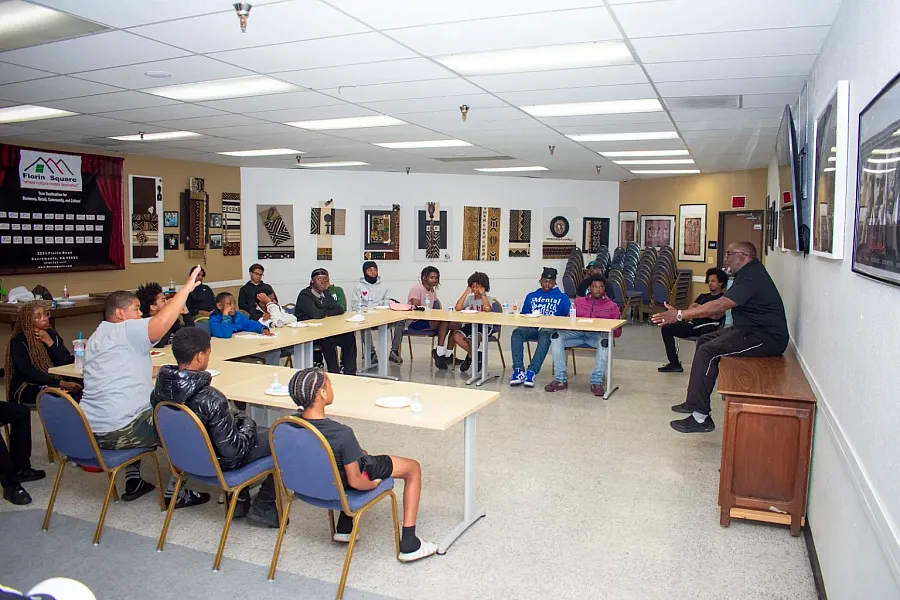
Timothy Poole, right, offers young men a safe space to talk about their feelings and the various stressors and challenges they face on a daily basis.
Russell Stiger Jr., OBSERVER
HOFNOV also supports a Spring Youth Mental Wellness Retreat to Folsom hosted by local school counselor Clara Brown through her non-profit organization, The Growth Center, Inc. This year’s retreat was held on April 6 and workshop topics ranged from nutrition to relationships.
“Stress that is not dealt with turns into mental health issues,” Brown said. “Those are things you live with for the rest of your life.”
At a recent meeting of Poole’s youth healing circle, Brown asked how many participants have a family member with a mental health diagnosis. While most of the hands in the room went up, a few of the young men seemed uncertain.
“If you don’t know, you should start asking questions,” Brown said. “Because as you get older, if it’s in your bloodline and you have these stressful moments in your life and you don’t ever bring that level down, you trigger that in your body. Then you start having mental health challenges.
A Matter of Exposure
Youth aren’t simply learning about violence, trauma and loss indirectly. Some deal with racism at school on a daily basis, both covert and overt. Many have parents who have been arrested. Others have seen their moms and dads be the victim or aggressor of unreported domestic violence or selling drugs or becoming addicted to them. Many participated in, and organized, local protests that gripped the city after the police-involved deaths of George Floyd and Stephon Clark. Images of both men’s deaths went viral, captured either by body-camera footage or witnesses’ cell phones. Footage galvanized the country around police-violence, but also gave it a jarring visual.
The Fortune School charter system has a school playground and a middle school named for Clark, a local Black man who was fatally shot by Sacramento police officers in March 2018, after mistaking his cell phone for a gun. Both the play area and the school are located steps away from where Clark was killed. Today Fortune School students get mental health support by way of several programs including Second Step, a social emotional curriculum for Pre-K to 8th graders. Scholars engage in daily lessons to acquire skills, knowledge and mindsets needed to persevere through challenges. A partnership with the Center for Fathers and Families provides Life Skills 911, a 12-day course that teaches coping skills, positive social interactions and emotion management. Through daily community circles, students learn to communicate respectfully and repair conflicts.
Man-To-Man
Ronnie Cobb, a youth basketball coach at Elk Grove Unified’s T.R. Smedberg Middle School, remembers addressing bullying after a white honor roll student, Joshua “JJ” Anderson, committed suicide in February 2016.
“He didn’t play on my team, but he was in Leadership with some of my players,” said Cobb, who also co-hosts a local Cut to the Chase mental health support group through the Greater Sacramento Urban League.
After the incident, the Sacramento Kings invited Cobb’s team to attend its anti-bullying and suicide prevention workshop. Two of the players put what they learned to immediate use, calling the coach the next day and asking him to check on another teammate who was posting concerning messages online.
“They said, ‘I just think he might be dealing with some of this bullying stuff and he doesn’t sound good,’” Cobb recalls.
He met with the young man and his parents and also talked with a boy who was bullying him. The young man was being harassed himself. Anti-bullying became the basketball team’s theme that year.
“I made it a point to be conscious of what mental illness can do to people,” Cobb said.
Smedberg saw another tragedy a year later when youth football coach Leslie Stafford was gunned down outside his Elk Grove home. The school hosted a gathering for students and staff to remember Stafford and process his death.
Crisis Mode
Suicide rates among African American youth have skyrocketed in recent years. According to the CDC, from 2018-2021, African Americans saw the largest increase, 37%, in suicides among young people ages 10-24. From 2000-2020, Black youth ages 10-19 jumped a jaw dropping 78%. Black children ages 5-12 were two times more likely to die by suicide than white children. Black adolescents who perceived racial discrimination were three times more likely to experience suicidal thoughts, make suicide plans and attempt suicide than those who don’t.
“It will not be easy to reduce the rates of Black youth suicide. What has been done thus far is not working,” wrote Dr. Arielle H. Shetfall, a University of Rochester Medical Center researcher and professor, in an 2023 article titled, “The Tragedy of Black Youth Suicide.”
Dr. Shetfall shared her own experience with having suicidal thoughts as a teen following the loss of her mother to breast cancer.
“We now need everyone vested in the problem to come to the table,” Dr. Shetfall continued. “Researchers, clinicians, policymakers, community leaders–and Black youth themselves– need to address the problem together.”
Emotional Black Male
Back in the day, tears got boys called sissies, cry babies or Mama’s boys. Today’s youth say “that’s gay.” Admitting issues is often viewed as a weakness, says Paul Moore, facilitator of ONTRACK Program Resources’ Black Men Alive & Well support group.
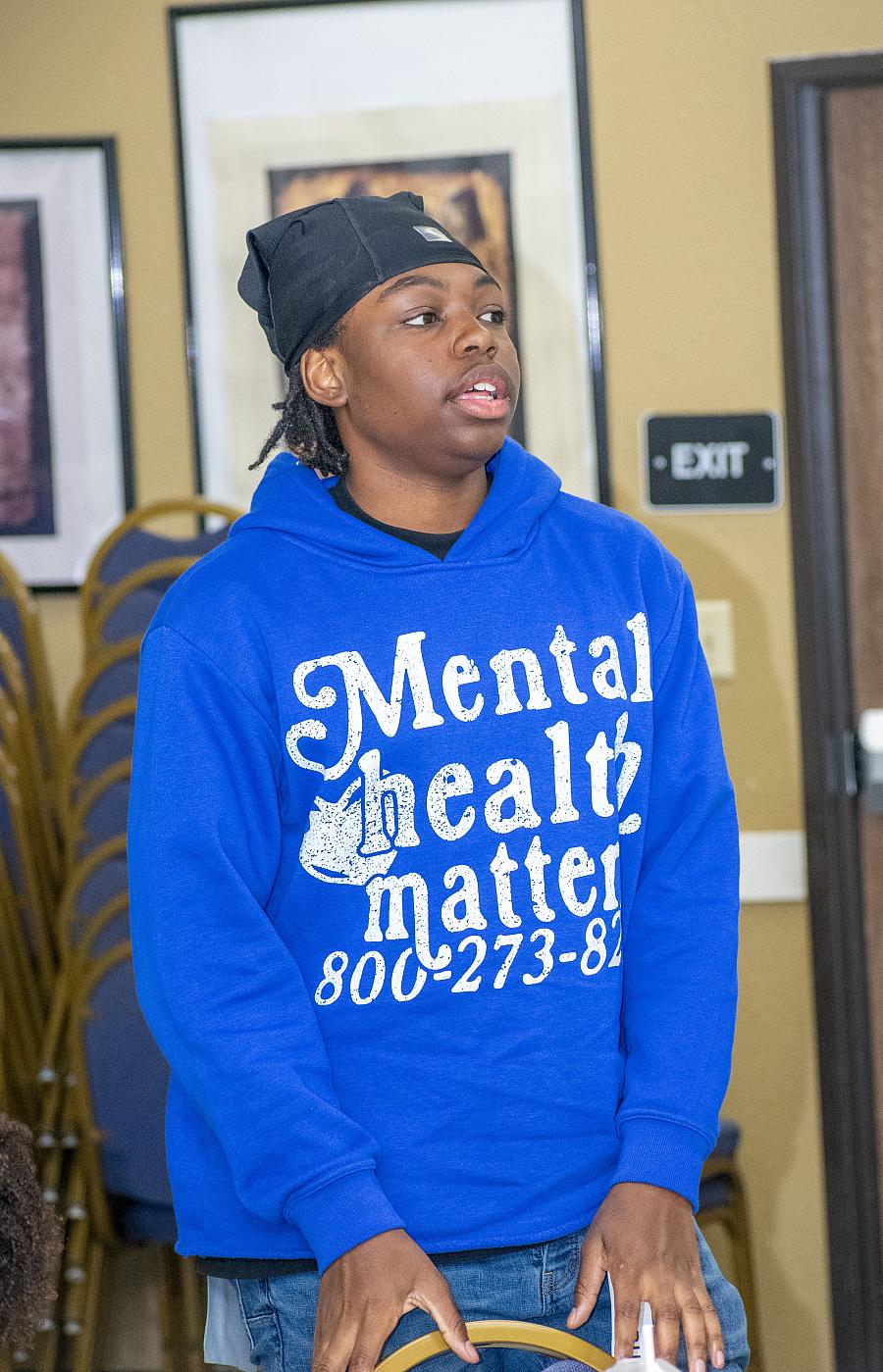
Black teens in hoodies are often racially profiled and stereotyped. A teen participant at a recent youth healing circle wore one calling for mental health awareness.
Russell Stiger Jr., OBSERVER
“Black men are conditioned from an early age not to express emotions,” Moore said. “These cultural and community conditionings set the tone for norms for young Black boys. There are all the labels they get. It’s a lot. Even the young brothas that we have coming (to the support group), it’s difficult to break through some of that. It takes a lot of internal work. It’s extremely difficult to challenge all your beliefs and all those ethos that you grew up with.”
Black Men Alive & Well group discussion often centers around masculinity and what participants’ fathers taught them about it.
“Mine was very pragmatic,” Moore said. “No hugging, no kissing. He died and I don’t ever remember getting a hug from him. He never said ‘I love you.’”
Moore chose to be the opposite with his own son.
“Even now, we don’t ever say goodbye without me letting him know that I love him.”
Moore, who recently shared his personal journey with mental illness with The OBSERVER, remembers getting “his ass beat” by his father for coming home crying about being bullied. He recalls being told to get a stick and go after the boy and that “he’d better not” come back crying again.
“What message are we sending?” Moore asked.
Mixed messages can mess with a man’s thinking, adds local nurse Aron King.
“We tell boys not to play with dolls, then when they get older, we say, ‘Here, go take care of this baby.’ The other example is, ‘Don't cry, don’t show your feelings,’ and then they’re in a relationship and you’re telling them, ‘Man, you’re never expressing your feelings, you don’t ever talk about them.’ That has to do a lot with how we’re conditioned,” King said.
King participates in the Cut to the Chase sessions and has co-hosted a number of his own barbershop health outreach efforts.
“There’s a very tiny range for how Black men can exist in our society,” Dr. Shim said. “We do not allow a range or spread of ways of being, for Black men and for Black boys, so they are taught very maladaptive ways to cope.
“Some of these behaviors end up looking like a condition of personality disorder, or willful conduct disorder in children, and then antisocial personality disorder in adults, which is a blatant disregard for the law or a lack of remorse,” she continued.
Personality disorder is something that’s overdiagnosed in prisons, Dr. Shim said, which impacts Black men, as they tend to be overrepresented in prison.
“It’s a condition where people say, ‘Oh, it's just a fundamental trait of your personality, it can’t be changed, you can’t really treat it, there's no effective way to manage it,’” Dr. Shim said. “From my perspective, it is people that didn't get interventions for the trauma that they experienced at a young age.”
“There’s a lot of young people that are out there that get caught up in the juvenile system that go undiagnosed,” Brown said. “That means that you might have some anger issues that you don’t ever deal with, then one day, you have a bad day, you’re triggered and that puts you in jail for the rest of your life, if you don’t learn healthy coping strategies.”
According to the Office of Juvenile Justice and Delinquency Prevention (OJJDP), witnessing violence can impact a child’s ability to learn and have long-term effects on one’s physical, emotional and intellectual development. The OJJDP adds, “exposure to violence often requires interventions that range from improving the environment of the child by enhancing protective factors, to reducing symptoms, to addressing underlying trauma. Early interventions for children who are already exposed enhance the children’s capacity to cope with ongoing stressors.”
The lack of early childhood intervention saddens Dr. Shim.
“It’s very disheartening and depressing to me, but time and time again, I think our society has proven that we really don’t value children that much,” she said. “We haven’t really demonstrated through our laws and our policies that we care about children. Until we get to a point where we’re willing to change that, I think we're going to continue to see really negative outcomes.”
The project is being supported by the USC Annenberg Center for Health Journalism and is part of “Healing California,” a yearlong reporting Ethnic Media Collaborative venture with print, online and broadcast outlets across California. The Sacramento OBSERVER is among the collaborative’s inaugural participants.

